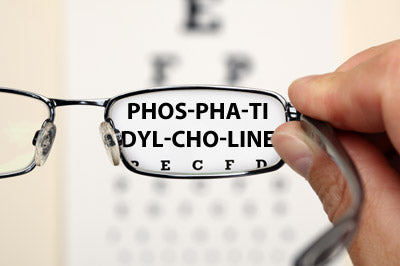Phosphatidylcholine and Vision: Will The Real PC Please Stand Up?
Authors:

Dr. Thomas Wnorowski
PhD, CNCC Research Director, BodyBio & Biomedical Nutritionist|
A disquieting commentary about a globally progressive mentality is that even the most highly educated among us can be misled into believing a falsehood, a misrepresentation often based on linguistic nuance. It’s all in the spin enunciated by those with a systematic plan to pull the undereducated into their fold. The point in this case is the semantic concerning phosphatidylcholine (PC), the phospholipid purposely and ignorantly confused with lecithin, a material that contains PC as its main constituent, but itself is not PC. Lecithin is an extracted and purified product made from soybeans, eggs, sunflower, or canola seeds, the last being genetically modified to make it what it is from rapeseeds. Lecithin is a natural emulsifier, keeping mayonnaise from separating, for example, but it contains triglycerides, sterols, fatty acids and carbohydrates that cause it to be digested in the gut before the phospholipid fraction can do its work in the cell membrane. True PC, the actual phospholipid, is an amphiphilic molecule, meaning that is has a polar, water-soluble group attached to a non-polar water insoluble hydrocarbon chain. It’s the primary component of the cell membrane and acts as a reservoir of choline for the obligatory manufacture of acetylcholine, the neurotransmitter in charge of nerve impulse transmission that enables muscle contraction, vasodilation, peristalsis and mood changes. Convention has permitted triple strength lecithin, which now is thirty-six percent phosphatidylcholine, to be called PC because of the chief constituent, adding to the confusion. Phosphatidylcholine is the largest fraction of the phospholipids that make the cell membrane. It’s accompanied by three others, however, including phosphatidylethanolamine (PE), phosphatidylserine (PS), and phosphatidylinositol (PI). Each of these fractions has its own character. PC is a famous molecule in its own right but, as an ancillary agent to the function of fat-soluble nutrients, it displays the loyalty of a favorite sidekick. Lutein is one of the major players in eye health and has been the focus of considerable study as a therapeutic and preventative agent in the treatment of the retinal diseases. Found in green leafy vegetables such as spinach and kale, lutein is a yellow carotenoid pigment that modulates light energy to serve as a photoprotector by absorbing blue light and inhibiting the consequent free radicals from exposure to it. The increases in pigmentation of the retina afforded by lutein protect the eye against macular degeneration and the formation of cataracts (Richer, 1999, 2004) (AREDS Study Group, 2001, 2007) (Barker, 2010). Should the retina be scourged by inflammation, lutein can serve as a rescue molecule (Sasaki, 2009) and help to prevent damage to the functional proteins rhodopsin and synaptophysin (Ozawa, 2012). Some pharmaceuticals and nutraceuticals need a supporting cast to enhance their performances. Such is phosphatidylcholine, an adjuvant that increases the bioavailability and efficacy of more than only a few therapeutic materials. Curcumin, the active ingredient of turmeric, is an anti-inflammatory agent with a substantial fan club. Combined with PC, curcumin enjoys increased respect in the clinical world, particularly in the treatment of uveitis, which is inflammation of the uvea, the part of the eye that includes the choroid, the ciliary body and the iris. Dry eye, maculopathy, glaucoma and diabetic retinopathy are other conditions addressed by using PC-enriched curcumin (Allegri, 2010). The retina is one of the vertebrate tissues with the greatest concentrations of polyunsaturated fats. Unlike most organs, though, the lens is another story, having a lipid composition that varies from species to species and with age. The sphingolipids and PC concentrations of the lens have been used to predict life span in some species, where humans have so adapted that their lens membranes have greater sphingolipids content to confer protection against oxidation, allowing the lens to remain clear longer than in other species (Borchman, 2004). Since the fibers of the human lens rely on phospholipids for their integrity, reductions in phospholipids may be predictive of cataracts, while simultaneously implying to clinicians that phospholipid intake will prevent, or at least slow, their progression (Siddique, 2010) (Deeley, 2010). As much as contemporary science would like to deem this a modern position on the architecture of the eye, the idea of ocular phospholipid degradation over time has been studied since the 1960’s, and perhaps earlier, when it was found that PC and PE do not exhibit phosphate turnover as readily as the other phospholipids, phosphatidic acid and PI, once more indicating a position of respect for PC (Broekhuyse, 1969). Behind the cornea and before the lens is the aqueous humor, the transparent gelatinous fluid made mostly of water plus a little bit of amino acid, electrolytes and vitamin C. It helps to maintain intraocular pressure, to protect the cornea against the environment and to refract light. In a normal eye, all four phospholipid fractions are present, but not in a glaucomatous one. Supplemental PC, then, has the potential to resolve such an issue, while maintaining the structure and function of the framework that scaffolds the anterior members of the eyeball (Edwards, 2014) (Abindi, 2013). There are mechanisms in the body that can make PC either from the methylation of PE or through the enlistment of a substance called citicoline, which directs the manufacture of PC from choline. Decreases in members of this cascade can change the phospholipid makeup of every cell, affecting every neuron of the central nervous system, of which vision is vital. To address this concern, PC is a desirable option, and both citicoline and exogenous PC have produced favorable results (Grieb, 2002) (Zigman, 1984). Whether we look for enhanced lutein (Lakshminarayana, 2006), a sophisticated phospholipid complex (Baskaran, 2003), or supercharged curcumin (Belcaro, 2010), we can rely on phosphatidylcholine to vitalize the cell membrane and all that it does for the eyes... and for all our other parts. |
Acar N, Berdeaux O, Grégoire S, Cabaret S, Martine L, Gain P, Thuret G, Creuzot-Garcher CP, Bron AM, Bretillon L. Lipid composition of the human eye: are red blood cells a good mirror of retinal and optic nerve fatty acids? PLoS One. 2012;7(4):e35102. Age-Related Eye Disease Study Research Group. A randomized, placebo-controlled, clinical trial of high-dose supplementation with vitamins C and E, beta carotene, and zinc for age-related macular degeneration and vision loss: AREDS report no. 8. Arch Ophthalmol. 2001 Oct;119(10):1417-36. Age-Related Eye Disease Study Research Group, SanGiovanni JP, Chew EY, Clemons TE, Ferris FL 3rd, Gensler G, Lindblad AS, Milton RC, Seddon JM, Sperduto RD. The relationship of dietary carotenoid and vitamin A, E, and C intake with age-related macular degeneration in a case-control study: AREDS Report No. 22. Arch Ophthalmol. 2007 Sep;125(9):1225-32. Allegri P, Mastromarino A, Neri P. Management of chronic anterior uveitis relapses: efficacy of oral phospholipidic curcumin treatment. Long-term follow-up. Clin Ophthalmol. 2010 Oct 21;4:1201-6. Anderson RE, Maude MB, Kelleher PA, Maida TM, Basinger SF. Metabolism of phosphatidylcholine in the frog retina. Biochim Biophys Acta. 1980 Nov 7;620(2):212-26. Aribindi K, Guerra Y, Lee RK, Bhattacharya SK. Comparative phospholipid profiles of control and glaucomatous human trabecular meshwork. Invest Ophthalmol Vis Sci. 2013 Apr 30;54(4):3037-44. Barker FM 2nd. Dietary supplementation: effects on visual performance and occurrence of AMD and cataracts. Curr Med Res Opin. 2010 Aug;26(8):2011-23. Baskaran V, Sugawara T, Nagao A. Phospholipids affect the intestinal absorption of carotenoids in mice. Lipids. 2003 Jul;38(7):705-11. Berdeaux O, Juaneda P, Martine L, Cabaret S, Bretillon L, Acar N. Identification and quantification of phosphatidylcholines containing very-long-chain polyunsaturated fatty acid in bovine and human retina using liquid chromatography/tandem mass spectrometry. J Chromatogr A. 2010 Dec 3;1217(49):7738-48. Belcaro G, Cesarone MR, Dugall M, Pellegrini L, Ledda A, Grossi MG, Togni S, Appendino G. Efficacy and safety of Meriva®, a curcumin-phosphatidylcholine complex, during extended administration in osteoarthritis patients. Altern Med Rev. 2010 Dec;15(4):337-44. R.M. Broekhuyse Phospholipids in tissues of the eye: III. Composition and metabolism of phospholipids in human lens in relation to age and cataract formation Biochim Biophys Acta. 1969 Oct 28;187(3):354-65. Deeley JM, Hankin JA, Friedrich MG, Murphy RC, Truscott RJ, Mitchell TW, Blanksby SJ. Sphingolipid distribution changes with age in the human lens. J Lipid Res. 2010 Sep;51(9):2753-60. Donoso LA, Edwards AO, Frost A, Vrabec T, Stone EM, Hageman GS, Perski T. Autosomal dominant Stargardt-like macular dystrophy. Surv Ophthalmol. 2001 Sep-Oct;46(2):149-63. Edwards G, Aribindi K, Guerra Y, Lee RK, Bhattacharya SK. Phospholipid Profiles of Control and Glaucomatous Human Aqueous Humor. Biochimie. 2014 Feb 20. pii: S0300-9084(14)00052-2. Frederik J. G. M. van Kuijk and Paul Duck Fatty Acid Composition of the Human Macula and Peripheral Retina Investigative Ophthalmology & Visual Science. Dec 1992; 33(13): 3493-6 Frederik J. G. M. van Kuijk and Paul Duck Fatty Acid Composition of the Human Macula and Peripheral Retina Investigative Ophthalmology & Visual Science. Dec 1992; 33(13): 3493-6 Grieb P, Rejdak R. Pharmacodynamics of citicoline relevant to the treatment of glaucoma. J Neurosci Res. 2002 Jan 15;67(2):143-8. Lakshminarayana R, Raju M, Krishnakantha TP, Baskaran V. Enhanced lutein bioavailability by lyso-phosphatidylcholine in rats. Mol Cell Biochem. 2006 Jan;281(1-2):103-10. Li LK, So L, Spector A. Membrane cholesterol and phospholipid in consecutive concentric sections of human lenses. J Lipid Res. 1985 May;26(5):600-9. Marisiddaiah R, Baskaran V. Bioefficacy of beta-carotene is improved in rats after solubilized as equimolar dose of beta-carotene and lutein in phospholipid-mixed micelles. Nutr Res. 2009 Aug;29(8):588-95. Nagy K, Brahmbhatt VV, Berdeaux O, Bretillon L, Destaillats F, Acar N. Comparative study of serine-plasmalogens in human retina and optic nerve: identification of atypical species with odd carbon chains. J Lipid Res. 2012 Apr;53(4):776-83. Oresic M, Seppänen-Laakso T, Yetukuri L, Bäckhed F, Hänninen V. Gut microbiota affects lens and retinal lipid composition. Exp Eye Res. 2009 Nov;89(5):604-7. Yoko Ozawa, Mariko Sasaki, Noriko Takahashi, Mamoru Kamoshita, Seiji Miyake, and Kazuo Tsubota Neuroprotective Effects of Lutein in the Retina Curr Pharm Des. Jan 2012; 18(1): 51–56. The Rigaku Journal. Vol. 17/ number 1/ 2000 Determination of human eye lens membrane structure by x-ray diffraction analysis ROBERT F. JACOB, RICHARD J. CENEDELLAH, AND R. PRESTON MASON Richer S. ARMD--pilot (case series) environmental intervention data. J Am Optom Assoc. 1999 Jan;70(1):24-36. Richer S, Stiles W, Statkute L, Pulido J, Frankowski J, Rudy D, Pei K, Tsipursky M, Nyland J. Double-masked, placebo-controlled, randomized trial of lutein and antioxidant supplementation in the intervention of atrophic age-related macular degeneration: the Veterans LAST study (Lutein Antioxidant Supplementation Trial). Optometry. 2004 Apr;75(4):216-30 Sasaki M, Ozawa Y, Kurihara T, Noda K, Imamura Y, Kobayashi S, Ishida S, Tsubota K. Neuroprotective effect of an antioxidant, lutein, during retinal inflammation. Invest Ophthalmol Vis Sci. 2009 Mar;50(3):1433-9. M A Siddique, B K Tiwary and S B Paul Phospholipid and protein contents of lens proteolipids in human senile cataract Eye (2010) 24, 720–727 Zigman S, Paxhia T, Marinetti G, Girsch S. Lipids of human lens fiber cell membranes. Curr Eye Res. 1984 Jul;3(7):887-96. |
